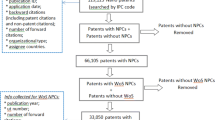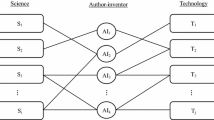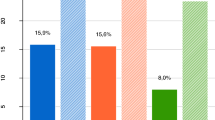Abstract
This paper aims to contribute to a better understanding of patent citation analysis in general and its application to novel fields of science and technology in particular. It introduces into the subject-matter by discussing an empirical problem, the relationship of nano-publications and nano-patents as representations of nano-science and nano-technology. Drawing on a variety of sources, different interpretations of patent citations are presented. Then, the nature of patent citations is further investigated by comparing them to citations in the scientific literature. After characterizing the citation linkage as indicators of reciprocal relationships between science and technology, patent citations in nano-science and technology are analyzed in terms of interfield and organizational knowledge-flows.
Similar content being viewed by others
References
M. Meyer, Commercializing Novel Technologies: Hurdles on the Way to Growth. Institute of Strategy and International Business, Helsinki University of Technology, Espoo, 2000.
F. Layton, Technology as knowledge. Technology and Culture, 15 (1988) 31-41.
M. P. Carpenter, F. Narin, Validation study: Patent citations as indicators of science and foreign dependence. World Patent Information, 5 (1983) 180-185.
D. De Solla Price, Is technology historically independent of science? Technology and Culture, 6 (1965) 553-568.
I. Malsch, Nanotechnology in Europe: Experts' Perceptions and Scientific Relations between Subareas. Institute for Prospective Technological Studies, Seville, 1997.
A. Franks, Nanotechnology, J. Phys E: Sci. Instrum., 20 (1987) 1442-1451.
D.W. Budworth, Overview of Activities on Nanotechnology and Related Technology. Institute for Prospective Technological Studies, Seville, 1996.
BMBF, Delphi-Bericht 1995 zur Entwicklung von Wissenschaft und Technik — Mini-Delphi. Bonn, 1996.
T. Braun, A. Schubert, S. Zsindely, Nanoscience and nanotechnology on the balance, Scientometrics, 38 (1999) 321-325.
M. Meyer, O. Persson, Nanotechnology — interdisciplinarity, patterns of collaboration and differences in application, Scientometrics, 42 (1998) 195-205.
F. Narin, Patent bibliometrics. Scientometrics, 30 (1994) 150.
F. Narin, K.S. Hamilton, D. Olivastro, The increasing linkage between U.S. technology and public science, Research Policy, 26 (1997) 318.
F. Meyer-Krahmer, U. Schmoch, Chemistry, Information Technology, Biotechnology, and Production Technology: A Comparison of Linking Mechanisms in Four Fields. Fraunhofer Institute for Systems and Innovation Research: Karlsruhe, 1997.
A. Rip, Science and technology as dancing partners. In: P. Kroes, M. Bakker (Eds), Technological Development and Science in the Industrial Age, Kluwer, 1992, pp. 231-270.
M. Meyer, What is special about patent citations? Differences between patent and scientific citations. To be published in Scientometrics.
R. D. Walker, Patents as Scientific and Technical Literature. The Scarecrow Press: Metuchen, NJ, and London, 1995.
Derwent, Global Patent Sources: An Overview of International Patents, Edition 2, February 1999, Derwent Information, London, 35.
H. Van Den Belt, Action at a distance: A.W. Hofmann and the French patent disputes (1860–1863), or how a scientist may influence legal decisions without appearing in court. In: R. Smith, B. Wynne (Eds), Expert evidence: interpreting science in the law. Routledge: London, 1989.
B. Campbell, Generalists, practitioners, and intellectuals: the credibility of experts in English patent law. In: R. Smith, B. Wynne (Eds), Expert Evidence: Interpreting Science in the Law. Routledge: London, 1989, pp. 210-236.
M. Meyer, What is special about patent citations, forthcoming, Scientometrics.
A. Rip, Mobilising resources through texts. In: M. Callon, J. Law, A. Rip (Eds), Mapping the Dynamics of Science and Technology, Macmillan: London, 1986, pp. 84-99.
P. Collins. S. Wyatt, Citations in patents to the basic research literature, Research Policy, 17 (1988), 65-74.
U. Schmoch, Tracing the knowledge transfer from science to technology as reflected in patent indicators, Scientometrics, 26 (1993) 193-211.
R. Bertram, personal communication.
L. Karlsson, personal communication.
Neue Presse, 13.3.1999, Patentamt kommt Fleiss der Erfinder kaum nach.
R. S. Campbell, A.L. Nieves, Technology Indicators Based on Patent Data: The Case of Catalytic Converters — Phase I Report: Design and Demonstration. Batelle Pacific Northwest Laboratories, 1979.
M. Meyer, O. Persson, Tracing Knowledge Flows in a Novel Field of Technology: Inventiveness and Interaction between Nano-Science and Nano-Technology. Final report for Ruben Rausings Fond, SPRU, University of Sussex, Brighton, November 1999.
Author information
Authors and Affiliations
Rights and permissions
About this article
Cite this article
Meyer, M. Patent Citations in a Novel Field of Technology — What Can They Tell about Interactions between Emerging Communities of Science and Technology?. Scientometrics 48, 151–178 (2000). https://doi.org/10.1023/A:1005692621105
Issue Date:
DOI: https://doi.org/10.1023/A:1005692621105




